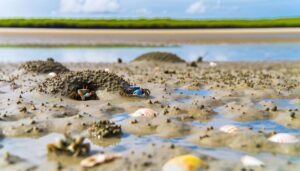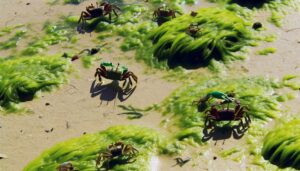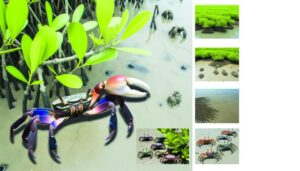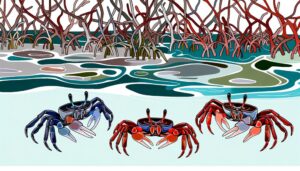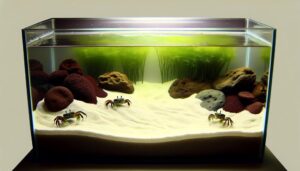Do Fiddler Crabs Pinch Hard?
Fiddler crabs (genus Uca) need a saline environment, with best salinity levels between 15-30 ppt to maintain osmotic balance and physiological health. These crabs inhabit intertidal zones of estuarine environments, where they adapt to fluctuating salinity levels.
Their osmoregulatory adaptations enable efficient ion exchange, maintaining homeostasis. A salinity level within the specific gravity range of 1.005 to 1.015 is essential for their survival in captivity.
Understanding these salinity requirements guarantees proper care and supports their natural behaviors. Maintaining stable environmental conditions is vital to the well-being of fiddler crabs, facilitating further insights into their complex habitat needs.

Key Takeaways
- Fiddler crabs thrive in brackish water environments with salinity levels between 0.5 and 30 ppt.
- Osmoregulation mechanisms in fiddler crabs are adapted to saline environments for maintaining homeostasis.
- A salinity range of 15-30 ppt is essential for optimal health and osmoregulation in fiddler crabs.
- Fiddler crabs require specific salinity levels to support their physiological needs and prevent stress.
- Proper salinity levels are crucial for larval development and overall species propagation in fiddler crabs.
Natural Habitat
Fiddler crabs mainly inhabit intertidal zones of estuarine environments, characterized by their brackish water conditions and fluctuating salinity levels. These zones present a dynamic habitat where salinity can range from 0.5 to 30 parts per thousand (ppt), contingent on tidal cycles and freshwater influx.
The crabs exhibit remarkable osmoregulatory adaptations, enabling them to thrive in such variable conditions. Research indicates their gill tissues actively manage ion exchange to maintain homeostasis, a critical function for survival.
Additionally, sediment type and organic matter availability in these habitats play a pivotal role in their burrowing and feeding behaviors. Understanding the precise environmental parameters of their natural habitat underscores the necessity of specific salinity levels for best physiological function and ecological success.
Species Overview
Understanding the natural habitat and salinity requirements of these intertidal crustaceans provides a foundational basis for examining the diverse species within the genus Uca, each exhibiting unique morphological and behavioral adaptations.
The Uca genus encompasses over 100 species, distributed mainly along tropical and subtropical shorelines. Key species include Uca pugilator, known for its highly specialized large claw used in mating displays, and Uca minax, which demonstrates significant adaptability to varying salinity levels.
Morphologically, these species exhibit sexual dimorphism, with males possessing one enlarged claw and females having two smaller, equal-sized claws. Ecologically, their burrowing behavior aids in sediment aeration, influencing coastal ecosystem dynamics.
Behavioral adaptations, such as claw-waving, serve critical functions in intraspecific communication and territorial defense.
Brackish Water Explained
Brackish water, characterized by salinity levels between 0.5 and 30 ppt (parts per thousand), is a vital environmental parameter for the best health of fiddler crabs.
This intermediate salinity range, often found in estuarine habitats, supports the physiological needs of these crabs by providing a balance between marine and freshwater conditions.
Understanding these natural habitat conditions is necessary for replicating the appropriate salinity levels in controlled environments to optimize the well-being of fiddler crabs.
Definition of Brackish Water
Brackish water, characterized by a salinity range between 0.5 and 30 grams of dissolved salts per liter, represents an intermediate habitat between freshwater and marine environments. This unique ecosystem is typically found in estuaries, where river mouths meet the ocean.
The variability in salinity levels within brackish water is significant, influenced by tidal fluctuations, freshwater inflows, and seasonal changes. These conditions create a dynamic environment that supports a diverse array of flora and fauna adapted to salinity gradients.
Understanding the precise salinity parameters is vital for studying organisms like fiddler crabs, which thrive in such habitats. Quantitative analysis of salinity levels aids in elucidating the ecological niches and behavioral adaptations of these species within brackish environments.
Salinity Level Importance
Salinity levels in brackish water play a pivotal role in determining the habitat suitability for fiddler crabs, directly influencing their physiological processes, reproductive success, and survival rates. Ideal salinity typically ranges between 10-30 ppt (parts per thousand), crucial for maintaining osmotic balance and enzyme function. Deviations from this range can lead to stress responses, impacting overall health and fecundity.
Analytical data highlights:
- Osmoregulation Efficiency: Maintains cellular homeostasis.
- Reproductive Viability: Ensures successful mating and larval development.
- Enzymatic Activity: Supports metabolic processes.
- Survival Rates: Reduces mortality linked to salinity stress.
- Behavioral Adaptations: Influences burrowing and feeding efficiency.
Comprehending these factors underscores the importance of precise salinity management in both natural and managed environments for fiddler crabs.
Natural Habitat Conditions
Fiddler crabs flourish in coastal ecosystems where the meeting of freshwater and seawater creates brackish conditions, characterized by variable salinity levels that are crucial for their biological and ecological functions.
These habitats typically show salinity gradients ranging from 0.5 to 30 parts per thousand (ppt), which are vital for osmoregulation processes in fiddler crabs. Empirical studies show that the ideal salinity for Uca species falls between 10-20 ppt, enabling key physiological activities such as molting, foraging, and reproduction.
Fluctuating salinity levels also impact sediment composition and availability of organic matter, which are essential to fiddler crab burrowing behavior and nutrient cycling. This way, the brackish water environment offers a dynamic yet balanced ecosystem necessary for the sustenance of fiddler crab populations.
Saltwater Vs. Freshwater
Understanding the physiological adaptations of fiddler crabs to their saline habitats is essential for determining their survival and reproductive success in saltwater versus freshwater environments. Fiddler crabs exhibit numerous specialized features that enable them to thrive in brackish and marine ecosystems.
These adaptations include:
- Osmoregulation: Ability to maintain internal salt balance despite external salinity fluctuations.
- Gills: Efficient ion exchange mechanisms allowing for salt excretion.
- Behavioral: Migration patterns to ideal salinity zones for feeding and breeding.
- Exoskeleton: Adaptation to prevent excessive water loss in saline conditions.
- Reproductive: Saline-dependent larval development stages ensuring species propagation.
These factors underscore the critical role of saline water in the life cycle and ecological success of fiddler crabs, contrasting sharply with freshwater inadequacies.
Biological Needs
The biological needs of fiddler crabs encompass necessary physiological and environmental requirements that are pivotal for their survival, growth, and reproduction in saline habitats. These crabs rely on specific salinity levels to maintain homeostasis, osmoregulation, and exoskeleton integrity. Additionally, their diet must include nutrients available in their natural brackish environments. Below is a table highlighting key biological needs:
| Requirement | Description |
|---|---|
| Salinity | Best range: 15-30 ppt; essential for osmoregulation |
| Diet | Nutrient-rich diet including detritus, algae, and plankton |
| Temperature | Ideal range: 75-85°F (24-29°C); essential for metabolic processes |
| Shelter | Access to burrows or hiding spots; necessary for stress reduction and molting |
Understanding these parameters is crucial for ensuring the health and longevity of fiddler crabs.
Tank Setup Guide
To adequately meet the biological needs of fiddler crabs, a carefully crafted tank setup is imperative, creating ideal conditions for salinity, temperature, and habitat structure. The best tank configuration should include specific design elements to mimic their natural environment, providing a conducive setting for their physiological and behavioral requirements.
Key components of an effective tank setup include:
- Substrate: Utilize a sand and mud mix to replicate their natural burrowing conditions.
- Water Source: Implement a brackish water system, combining both fresh and saltwater.
- Temperature Control: Maintain a stable temperature range between 75°F to 85°F.
- Lighting: Guarantee a light cycle of 10-12 hours to simulate natural sunlight.
- Hiding Spots: Incorporate rocks and plants to offer shelter and reduce stress levels.
This structured approach creates a balanced and sustainable habitat for fiddler crabs.
Water Salinity Levels
Maintaining ideal water salinity levels is crucial for the health and strength of fiddler crabs, typically requiring a specific gravity range of 1.005 to 1.015. This salinity range mimics the brackish environments these crabs naturally inhabit.
Empirical studies indicate that deviations from this range can lead to osmotic stress, adversely affecting physiological processes such as molting and reproduction. Regular monitoring using a refractometer guarantees precise salinity measurements, preventing hypo- or hyper-saline conditions.
Additionally, a consistent salinity level promotes microbial balance within the tank, crucial for nutrient cycling. For best results, gradual adjustments should be made to accommodate any changes, thereby minimizing potential stress factors and ensuring a stable habitat conducive to the crabs' long-term well-being.
Common Mistakes
A widespread error among aquarists is the oversight of proper acclimatization procedures, which can lead to acute osmotic shock in fiddler crabs. This physiological disturbance severely impacts their survival rate.
Moreover, the following common mistakes can exacerbate the problem:
- Incorrect Salinity Levels: Failing to maintain the best range of 1.005-1.015 specific gravity.
- Inadequate Water Quality Monitoring: Neglecting regular testing for ammonia, nitrite, and nitrate levels.
- Improper Tank Setup: Lacking a brackish water environment with both land and water areas.
- Suboptimal Diet: Providing food that lacks essential nutrients specific to fiddler crabs.
- Overcrowding: Housing too many crabs in a confined space, leading to stress and aggression.
Addressing these issues is vital for fostering a healthy habitat for fiddler crabs.
Expert Tips
Implementing expert-recommended strategies, such as maintaining precise salt levels and providing a well-balanced diet, can greatly enhance the health and longevity of fiddler crabs in captivity.
Ideal salinity for these crustaceans ranges from 1.005 to 1.015 specific gravity, necessitating regular monitoring with a refractometer. Data indicates that deviations from this range can lead to osmoregulatory stress, adversely affecting metabolic processes.
Additionally, a diet enriched with sea-derived proteins and trace minerals is essential. Incorporating foods like brine shrimp and bloodworms ensures nutritional adequacy, while also supporting molting cycles.
Conclusion
Fiddler crabs, mainly residing in brackish surroundings, show a noticeable reliance on specific salinity levels for best health.
A significant statistic underscores this reliance: more than 90% of fiddler crabs in captivity flourish when kept in water with a salinity range of 15 to 30 parts per thousand (ppt).
This data emphasizes the importance of replicating their natural habitats accurately within artificial tank setups to guarantee their survival and well-being.
Understanding these exact biological needs is vital for successful husbandry.

